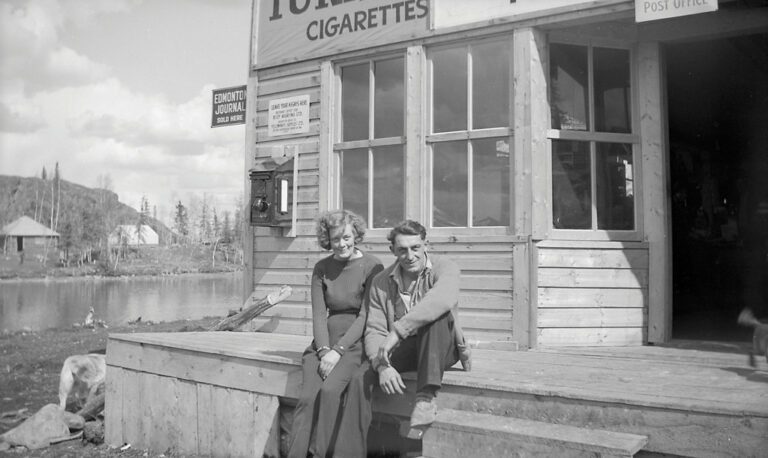Picture this: mid-winter heating bills under $100; a five-storey greenhouse in Yellowknife heated by the byproduct of methane-driven power turbines; a production plant for an international pipeline manufacturer in Fort Enterprise; and a pipeline, spooled out the back of ships into open water or laid along the ice pans, all the way to the North Pole – for sovereignty’s sake!
This was the dream Richard Lafferty, an entrepreneur from Fort Providence, spun to Yellowknife City Council during Monday’s Municipal Services Committee Meeting. It’s called the Flashpoint Corridor, and Lafferty has been working on the plan for 13 years.
At the core of Lafferty’s $230-million vision for bringing cheaper energy to the North are a bundle of high-tech flexible pipelines, produced by UK-based offshore pipeline manufacturer Wellstream International, that he proposes should cross the territory in thin trenches dug through soil and bedrock. (The Yellowknife greenhouse, the pipeline to the North Pole and the pipeline production plant in Enterprise are all secondary, or tertiary parts of the plan). Lafferty envisions three six-inch pipelines in the bundle: one carrying natural gas, one for oil and one with fibre-optic cables. The planned route would follow the side of the highway to north of Great Slave Lake, though branch lines would cut off to service the mines and smaller communities.
“We would be using NWT gas, which is shipped across the border, cleaned up, shipped east to Steen River [Alberta]… and there we would connect and bring our gas back north,” said Lafferty, adding that “there’s enough gas under Fort Providence to supply our North for at least 100 years.”
Using natural gas to heat the communities would be vastly cheaper and more environmentally friendly than diesel, Lafferty told a rapt council.
How much cheaper would it be for Yellowknifers? Well if council can help his company apply for $7 million in CANOR funding to do a front-end engineering and design assessment he can get that number, he said. But it would be considerably cheaper he assured coun. Niels Konge, the one councillor asking pointed questions about the project.
Does the project have legs?
The plan is intriguing, to say the least, though it’s difficult to say whether it’s visionary or quixotic. It’s unclear how seriously other orders of government are taking the project. Lafferty says he’s met with Minister David Ramsay, who has promised him a meeting with Transportation Minister Tom Beaulieu and Finance Minster Michael Miltenberger in the coming months.
Dave Nightingale, director of energy policy and planning with the Department of Industry and Tourism and Investment said he’s heard about the proposal.
“We’re supportive of anybody trying to reduce energy costs,” said Nightingale, “but we’d need to see a business plan that answers questions about the economics of the project, industry partnerships and access to capital, and perhaps some initial discussion on potential regulatory requirements.”
Lafferty said he’s in discussion with the Deton Cho Corporation and the development corporations for the Deh Cho and the Tlicho, and is hoping each take 20 percent shares in the project.
“I don’t think anyone on the planet would object to the First Nations in the three regions this is going to be installed in taking a lead in installing infrastructure that would reduce greenhouse gas emissions and provide us a lower cost of living,” he said.
As for funding the project: he hopes once he gets support from the municipalities across the territory, the GNWT and the mines, he’ll be able approach banks and get the necessary capital.
Big project for little outfit
The plan for funding the project does raise some immediate questions. Two-hundred and twenty-seven million is a big chunk of cash, and at one point in the presentation, he said that number might balloon to $500 million. Usually, major oil and gas companies build projects of this scale, not small groups of comprised of an entrepreneur, Lafferty, and two engineers.
Lafferty seemed confident he could get bank capital on board if he convinced the mines to use his gas pipeline. But one must question if banks would really throw hundreds of millions towards infrastructure serving mines with relatively limited lifespans.
When asked why he hadn’t approached large oil companies with the plan, he responded: “First of all, we don’t need them,” and then continued to say they wouldn’t be interested in a project given the small customer base in the territory. “I’m from here and I want this to be owned by us, and operated by us for us with our gas.”
One of the project’s biggest unknowns is how much Yellowknifers would actually end up paying when you account for the amount it would cost to run gas infrastructure through the streets of the city, and the amount people would have to spend changing over their appliances from diesel to gas. Lafferty suggested that Yellowknifers could form a co-op, which would pay for the retrofits and then add $10 or $20 to the heating bill each year. The bills would be so much cheaper, it would easily balance out, he claimed.
How did he figure this?
At numerous points during his presentation he said northerners pay, on average, $42.75 per gigajoule of heat produced by diesel fuel while a gigajoule could be produced with natural gas for $2.71. However, as Konge pointed out, that’s comparing the retail price for diesel with the wholesale price for natural gas.
“My guess is, that $40 range gets eaten up pretty quick, and those end-user dollars really is what I need to see to throw my support on a project like this,” said Konge. He also pointed to Inuvik’s recent experiment with natural gas. “It was supposed to be so cheap. And that certainly wasn’t the case. People are switching back to diesel because the costs incurred were not what they were told.”
It’s not surprising that some councillors seemed entranced by Lafferty’s presentation; it isn’t every Monday afternoon such an ambitious panacea for energy and environmental woes comes before them. But there are a lot more questions Lafferty will have to answer before his project seems like anything more than a pipe dream.







